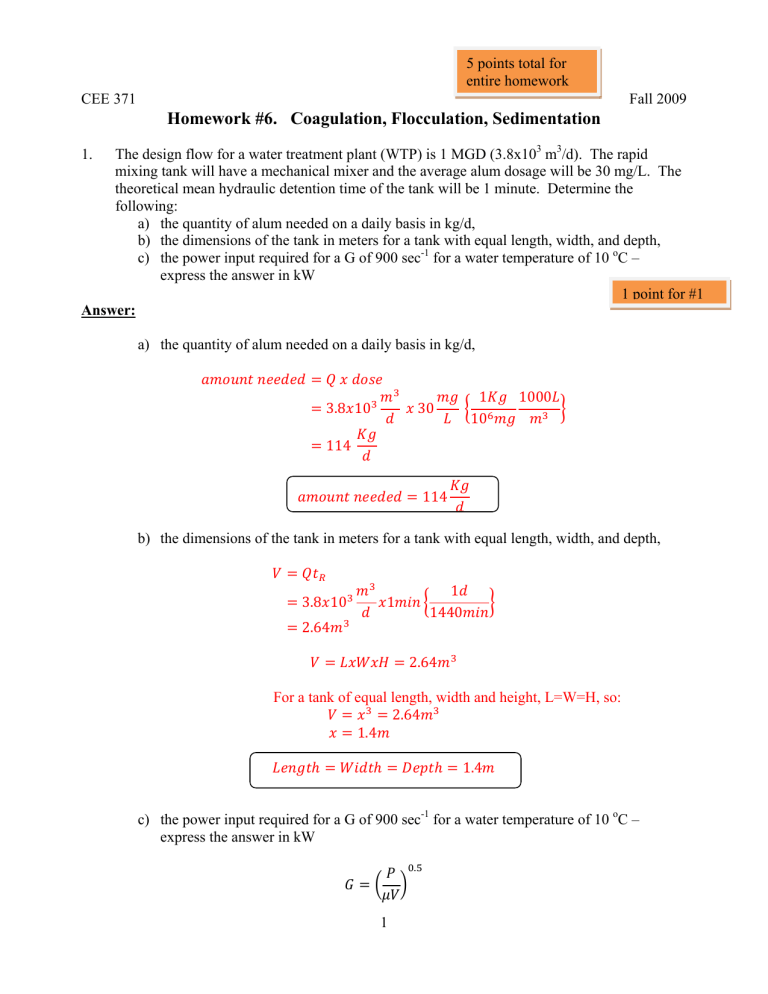
5 points total for entire homework CEE 371 Fall 2009 Homework #6. Coagulation, Flocculation, Sedimentation The design flow for a water treatment plant (WTP) is 1 MGD (3.8x103 m3/d). The rapid mixing tank will have a mechanical mixer and the average alum dosage will be 30 mg/L. The theoretical mean hydraulic detention time of the tank will be 1 minute. Determine the following: a) the quantity of alum needed on a daily basis in kg/d, b) the dimensions of the tank in meters for a tank with equal length, width, and depth, c) the power input required for a G of 900 sec-1 for a water temperature of 10 oC – express the answer in kW 1 point for #1 Answer: 1. a) the quantity of alum needed on a daily basis in kg/d, 1 10 30 3.8 10 1000 114 114 b) the dimensions of the tank in meters for a tank with equal length, width, and depth, 3.8 10 1 1440 1 2.64 2.64 For a tank of equal length, width and height, L=W=H, so: 2.64 1.4 1.4 c) the power input required for a G of 900 sec-1 for a water temperature of 10 oC – express the answer in kW . 1 So 1.307 10 2.64 900 2795 2.8 Note that: 2. 3 Flocculation tanks are to be designed for a total flow rate of 49,200 m /d. The following conditions apply to the design: water temperature of 10 oC, total mean detention time of 45 min, basin depth of 3.5 m, 3 parallel trains of flocculators (each train receives one third of the total flow), 3 flocculation stages of the same dimensions for each train (so a total of 9 flocculators), the first stage G is 50 sec-1, the second stage G is 35 sec-1, and the third stage G is 20 sec-1. Determine: a) The dimensions of the tank for each stage as well as the overall dimensions, in meters, 1 point for #2 Q V=tR/Q ,where tR per stage is 45/3 or 15 min Q per train is 1/3 times 49,200 m3/d or 16,400 m3/d 15 9 16,400 9 171 171 1,538 If the depth must be 3.5 m, then the product of the length and width must be: 171 3.5 1,538 3.5 48.8 439 Any combination of length x width that gives the above square meter areas is OK, as long as the L/W ratio doesn’t become too great (i.e, it should be below 10). 2 For example, if you assume each floc tank is square, then the dimensions are just the square root of above: • Each individual tank is 7m x 7 m x 3.5 m depth • Overall size is 21m x 21m x 3.5 m depth b) the average G times detention time product (the “Gt” Camp parameter) for the overall process and compare to the Camp criterion, and overall G is just the average for all of the flocculator tank volume 50 35 3 35 20 45 60 35 94,500 This is OK as it falls between 50,000 and 100,000 c) the power required for each stage, in kW. Recall that: 1.307 10 171 which results in the following Stage 1 2 3 3. G 50 35 20 P (kW) 0.56 0.27 0.089 Using Stokes Law for particle settling velocity, a) Calculate the settling velocity in m/hr of a 100 μm particle with a density of 1050 kg/m3 for water temperatures of 4, 10, 20, and 30 oC. Tabulate your results. 1 point for #3 Assume low Reynolds number which allows use of the simple stokes equation: 18 Which leads to the following: Temp o ρw 3 µ v v/v20 (m/hr) (%age) 3 ( C) (Kg/m ) (10 Kg/m-s) 4 1000 1.57 3 0.62 62% 10 20 30 999.7 998.2 995.7 1.307 1.002 0.798 0.75 1.01 1.33 74% 100% 132% b) Using 20 oC as a reference temperature, compute the relative settling velocity in % (i.e., the settling velocity for the stated temperature divided by the 20 oC settling velocity) for water temperatures of 4, 10, 20, and 30 oC. Tabulate these results along with those of part a). See table above 4. Settling of Alum floc a) Compute the settling velocity (in m/hr) of alum floc particles of 100 and 200 μm diameter at water temperatures of 4 and 20 oC (four calculations are required). Alum floc has a density of 1010 kg/m3. 1 point for #4 Again, you should assume a low Reynolds number which allows use of the simple stokes equation (you will check this assumption in part b): 18 This leads to the following: Temp d ρw µ v (oC) (µm) (Kg/m3) (Kg/m-s) (m/hr) 1000 1.57 x 10-3 998.2 1.002 x 10-3 4 20 100 200 100 200 0.13 0.50 0.23 0.92 Re 0.0022 0.018 0.0064 0.051 b) Compute the Reynolds numbers for all settling velocities of part a). Does Stokes Law for laminar flow conditions hold for these particles? Calculate Reynolds number for each See table above Since all are less than 0.2, we can assume laminar flow conditions1 5. For a WTP with a design flow of 1.5 MGD, determine the dimensions (in ft) for a rectangular sedimentation basin with a detention time of 4 hr, an overflow rate of 700 gpd/ft2, and length to width ratio of 3 to 1. 1 This is the value commonly used to distinguish laminar flow for discrete settling; note that this is different than the value used with open channel flow or flow in pipes (2000-4000) 4 1 point for #5 OFR = Q/A So: 1.5 10 2143 700 And But since L/w = 3: 3 3 or 3 2143 3 26.7 So, use 27 ft nominal width And thus, 81 ft nominal length Now determine the depth from the detention time Or rearranging: 4 1.5 10 81 So, use 16 ft nominal depth 5 27 . 15.3




